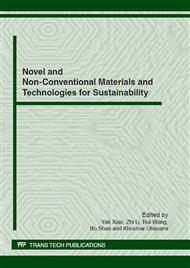[1]
Liese W. Reseach on bamboo . Wood Science Technology. 1987; 21: 180-209.
Google Scholar
[2]
Zhang,Q. S, Jiang, Sh.X. Tang Y.Y., Industrial utilization on bamboo, Technical Report No. 26, International Network for Bamboo and Rattan, (2002).
Google Scholar
[3]
Hutchings BF, Leicester RH. Scrimber. In: Proceedings of the 1988 international conference on timber engineering. 1988; Vol 2, pp.525-533.
Google Scholar
[4]
Jordan BA Scrimber: the leading edge of timber technology. In: Proceedings of 2 n~ pacific timber engineering conference, 1989; Vol 2: 13-15.
Google Scholar
[5]
Li, Q. Wang K.H. Hua X.Q. Weng P.J. He.Q.J. Experimental research on recombination bamboo timber made from small-sized sundry bamboo timber(In Chinese). Journal of Bamboo Research. 2002; 21(3): 33-36.
Google Scholar
[6]
Naresworo Nugroho. Naoto Ando. Development of structural composite products made from bambooII: fundamental properties of bamboo zephyr board. Journal of Wood Science, 2001; 47: 237-242.
DOI: 10.1007/bf01171228
Google Scholar
[7]
Naresworo Nugroho. Naoto Ando. Development of structural composite products made from bamboo I: fundamental properties of bamboo zephyr board. Journal of Wood Science, 2000; 46: 68-74.
DOI: 10.1007/bf00779556
Google Scholar
[8]
Guan M J, ZHU, Y. X; ZHAN X.A. Comparison of bending properties of scrimber and bamboo scrimber (In Chinese). Journal of Northeast Forestry University. 2006; 34(4): 20-21.
Google Scholar
[9]
Zhang B.Y. . Recombined bamboo, a new sustainable development material for good quality furniture (In Chinese). Furniture, 2008; No. 164 /3: 64-65.
Google Scholar
[10]
Aguilera A, Martin P. Machining qualification of solid wood of Fagus silvática L. and Picea exelsa L.: cutting forces, power requirements and surface roughness. Holz Roh-Werkst 2001; 59(6): 483.
DOI: 10.1007/s001070100243
Google Scholar
[11]
Fujiwara Y, Fujii Y, Okumura S. Relationship between roughness parameters based on material ration curve and tactile roughness for sanded surface of two hardwoods. Journal of Wood Science, 2005; 51: 274-277.
DOI: 10.1007/s10086-004-0649-8
Google Scholar
[12]
Kilic M, Hiziroglu S. Burdurlu E. Effect of machining on surface roughness of wood. Building and Environment. 2006; 41(8): 1074-8.
DOI: 10.1016/j.buildenv.2005.05.008
Google Scholar
[13]
Stewart HA, Murmaris L, River BH. Surface and subsurface characteristics related to abrasive-planing conditions. Wood and Fiber Science 1986; 18(1): 107-17.
Google Scholar
[14]
Lavery Dj, Mc Larnon D, Taylor JM, Moloney S, Atanackovic A. Parmeters affecting the surface finish of planed Stika spruce. Forests Products Jounral 1995; 45: 445-50.
Google Scholar
[15]
Malkoçoğlu A. Machining properties and surface roughness of various wood species planed in different conditions. Building and Environment. 2007; 42(7): 2562-2567.
DOI: 10.1016/j.buildenv.2006.08.028
Google Scholar
[16]
ASTM D 1667-87(Reapproved 1999) Standard methods for conducting machining of wood and wood-Base Materials.
Google Scholar
[17]
GB/T 12472. National standard of the P.R. China. Geometrical product specifications (GPS)—Surface texture: profile method surface roughness parameters and their values for wooden pieces, (2003).
DOI: 10.3403/02337030
Google Scholar


